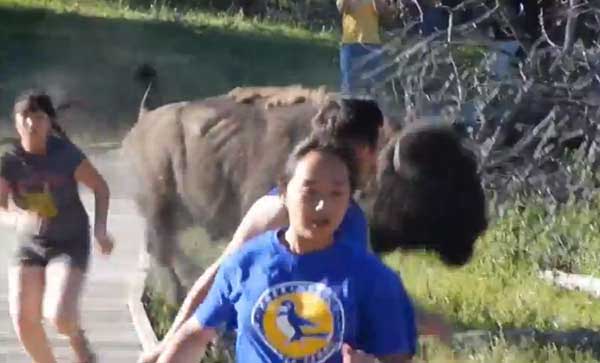
By Ruffin Prevost
CODY, WYO. — With fall approaching in the high country of Yellowstone National Park, animals are moving to lower elevations, prompting park officials to issue a seasonal warning about staying clear of wildlife. Proving the point, a viral video of a Yellowstone bison chasing a boy is attracting plenty of attention online.
Park regulations require people to stay at least 100 yards from wolves and bears, and 25 yards from other large wildlife like elk and bison. Both bison and elk become more aggressive during their seasonal mating periods, and park officials want to make sure visitors don’t get too close.
That’s exactly what happened in a 90-second vacation video called Bison Fury, viewed more than 100,000 times since it was uploaded Aug. 4 to to YouTube.
In the short clip, a group of kids and adults are standing along what appears to be a Yellowstone Park boardwalk with a bison grazing on green grass just a few feet away. Some of the kids want to move along the boardwalk past the bison, but are rightfully wary. Some adults stand by taking photos or video.
Some people pass by the bison while someone can be heard off-camera warning that the bison appears to be agitated. As if on cue, the bison decides it has had enough of the close-quarters crowding and leaps onto and over the boardwalk, charging the group. It ends up picking out a young boy and briefly chasing him around a fallen tree before breaking away.
The boy and the group are scared and amused, perhaps unaware of how close the situation came to being another statistic in a long list of wildlife-related injuries in the park.
Park officials on Wednesday released a statement warning that several large bull elk venture into the Mammoth Hot Springs area each fall to compete for the attention of cow elk during the seasonal rut.
Bulls at this time of year can be a threat to people and property. Several vehicles are damaged by elk every year, and on occasion, people are injured by charging elk. Park staffers typically patrol the Mammoth area in the late summer and early fall, working to keep visitors and elk separated and safe.
Grizzly bears and black bears are moving to higher elevations lately to feed on this year’s abundant crop of whitebark pine seeds in order to store the calories they need during winter hibernation. They may be encountered along roads through mountain passes or on hiking trails.
Visitors should keep food, garbage, barbecue grills and other attractants stored in hard-sided vehicles or bear-proof food storage boxes when not in immediate use.
Bears that get human food or garbage usually become aggressive in their efforts to get it again. This can result in property damage and or injury to people. When bears become a threat to human safety, they may have to be captured and euthanized.
Hikers and backpackers are encouraged to travel in groups of three or more, make noise on the trail, and keep an eye out for bears. Bear pepper spray has proven to be a good last line of defense if kept handy and used according to directions when the bear is within 50 feet.
Contact Ruffin Prevost at 307-213-9818 or [email protected].

People can be such dumbasses,,,,,,,and they wonder WHY they get hurt or killed by these animals!!!!!!!
Gina — I couldn’t agree more. We visited YS 3-years back and saw the same behavior. I was just amazed.